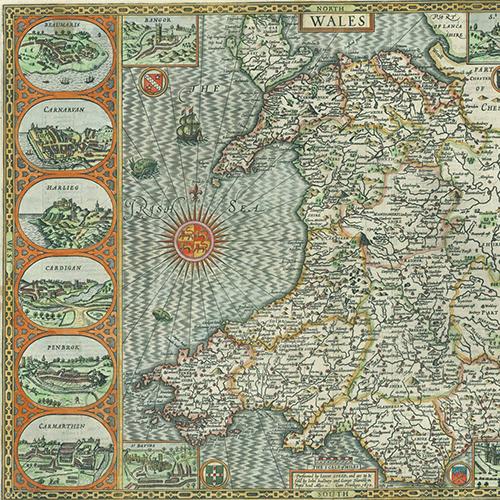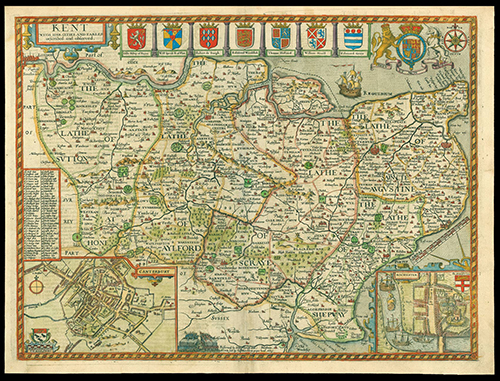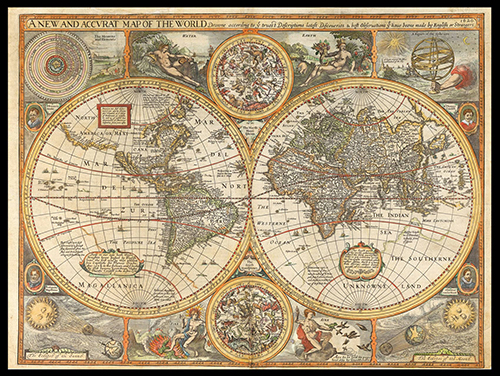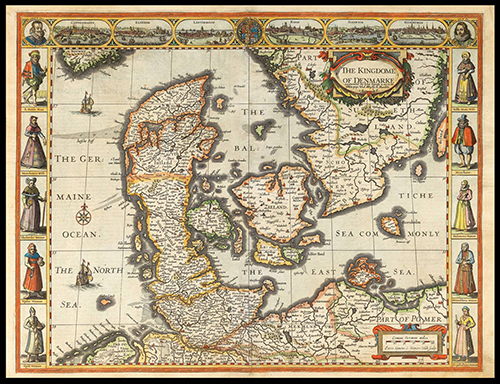

The Makers Series: John Speed
One of the finest cartographers and historians of the Elizabethan era, John Speed’s work influenced generations and helped unite our disparate regions by establishing the notion of a British national identity.
Although contemporary records are unclear, it is said that Speed was born in the village of Farndon, Cheshire in 1551 or 1552. It is thought that his mother died in childbirth or shortly after, since his father, also John Speed, is understood to have remarried by 1556.
Speed senior was a member of the Worshipful Company of Merchant Taylors, an honour his son would inherit in 1580, although ultimately his talents lay outside of the confines of tailoring. In 1582 he married Susanna Draper and leased a tenement in Moorgate from the Merchant Taylors' Company, where the pair are believed to have raised 12 sons and 6 daughters.
Speed’s move into the world of map making and historical record was facilitated by the patronage of influential benefactors, not least of which being Fulke Greville, The Lord Brooke (1554-1628). A poet, member of parliament and later Chancellor of the Exchequer, Greville determined to set Speed’s “hand free from the daily imployments of a manuall trade”.
 Speed partnered with the Puritan scholar and theologian Hugh Broughton (1549-1612) on the latter’s publication ‘A Concent of Scripture’ in 1590. This inspired Speed’s first chart in 1595, a map of Canaan, complete with biblical details including the Story of the Exodus and Jonah and the Whale. Today, the sole copy of the map can be found at the National Library of Israel in Jerusalem.
Speed partnered with the Puritan scholar and theologian Hugh Broughton (1549-1612) on the latter’s publication ‘A Concent of Scripture’ in 1590. This inspired Speed’s first chart in 1595, a map of Canaan, complete with biblical details including the Story of the Exodus and Jonah and the Whale. Today, the sole copy of the map can be found at the National Library of Israel in Jerusalem.
Speed spent much of his spare time working on detailed maps of the counties of England. At Fulke Greville’s request, Speed presented a series of these works, together with the Canann map to Queen Elizabeth in 1598. The Queen further enhancing Speed’s income with the granting of a lucrative Waiter position at the Custom’s House.
A decade later he was granted a Royal patent by King James I to publish a volume of religious research, ‘Genealogies recorded in Sacred Scripture’. Featuring celebrated illustrations of Adam and Eve and the Tree of Nations rising from Noah’s Ark, the genealogies were incorporated into the first edition of the King James Bible in 1611. The resulting revenue would afford Speed a comfortable lifestyle.
 That same year Speed published his remarkable collection of British history and cartography for the first time as “Theatre of the Empire of Great Britaine”. His previous work with Hugh Broughton brought Speed under the auspices of the College of Antiquaries, whose members’ knowledge of the origins of the English people would prove invaluable in compiling the historical research for his new venture.
That same year Speed published his remarkable collection of British history and cartography for the first time as “Theatre of the Empire of Great Britaine”. His previous work with Hugh Broughton brought Speed under the auspices of the College of Antiquaries, whose members’ knowledge of the origins of the English people would prove invaluable in compiling the historical research for his new venture.
In addition to the detailed history of Britian, the finished folio comprises a complete set of county maps of England and Wales, together with general maps of Scotland and Ireland, with many of the locations surveyed by Speed himself. The work is dedicated to King James I for uniting the Kingdoms of the British Isles into an Empire and played a key early role in the establishment of the new British identity.
In 1627 Speed published a new collection of cartography, ‘A Prospect of the Most Famous Parts of the World’, making him the first Englishman to produce a world atlas. The global collection was coupled with his earlier UK maps from the Theatre of the Empire and retailed at an eye-watering 40 shillings, more than £130,000 by today’s standards.
 John Speed passed away in July 1629, yet his work continued to form the basis for world cartography more than a century after his death. He was buried at St Giles-without-Cripplegate church in London where a bust in his honour can still be found in the South Aisle alongside luminaries such as the authors John Milton, Daniel Defoe and John Bunyan.
John Speed passed away in July 1629, yet his work continued to form the basis for world cartography more than a century after his death. He was buried at St Giles-without-Cripplegate church in London where a bust in his honour can still be found in the South Aisle alongside luminaries such as the authors John Milton, Daniel Defoe and John Bunyan.
Click here to view examples of Speed’s work currently available from BADA members.

